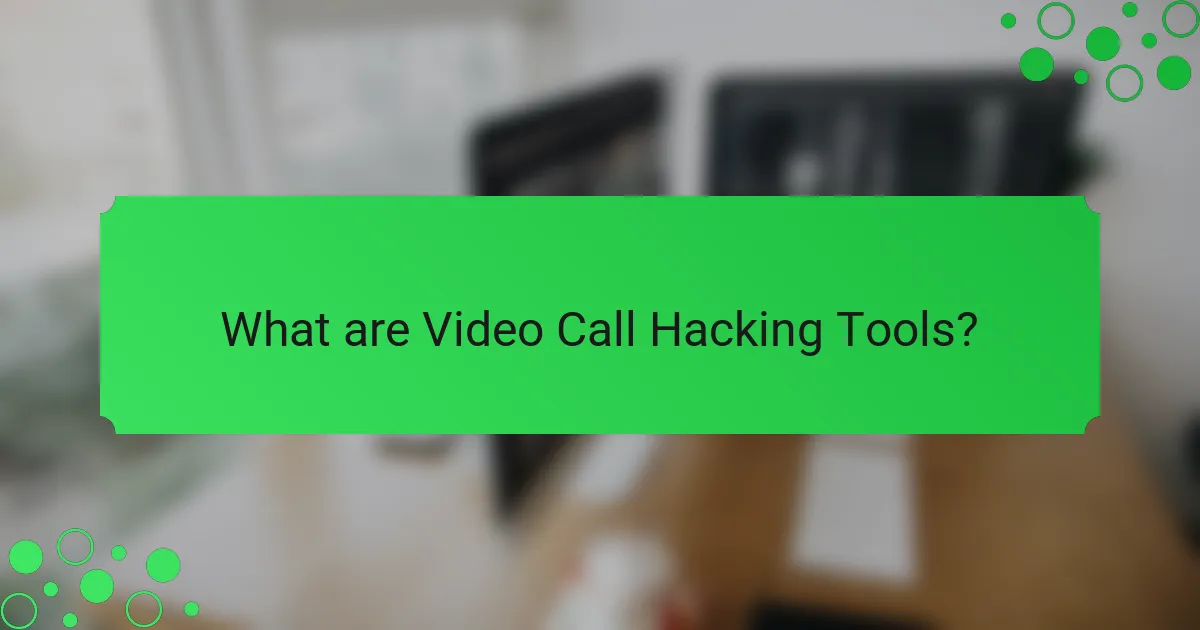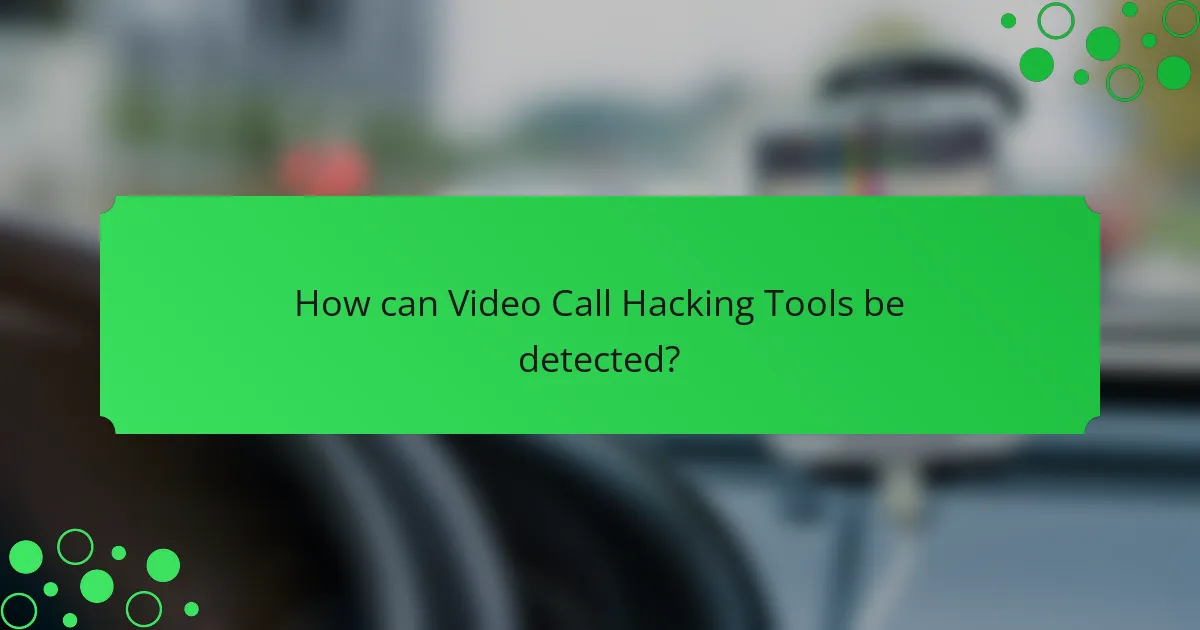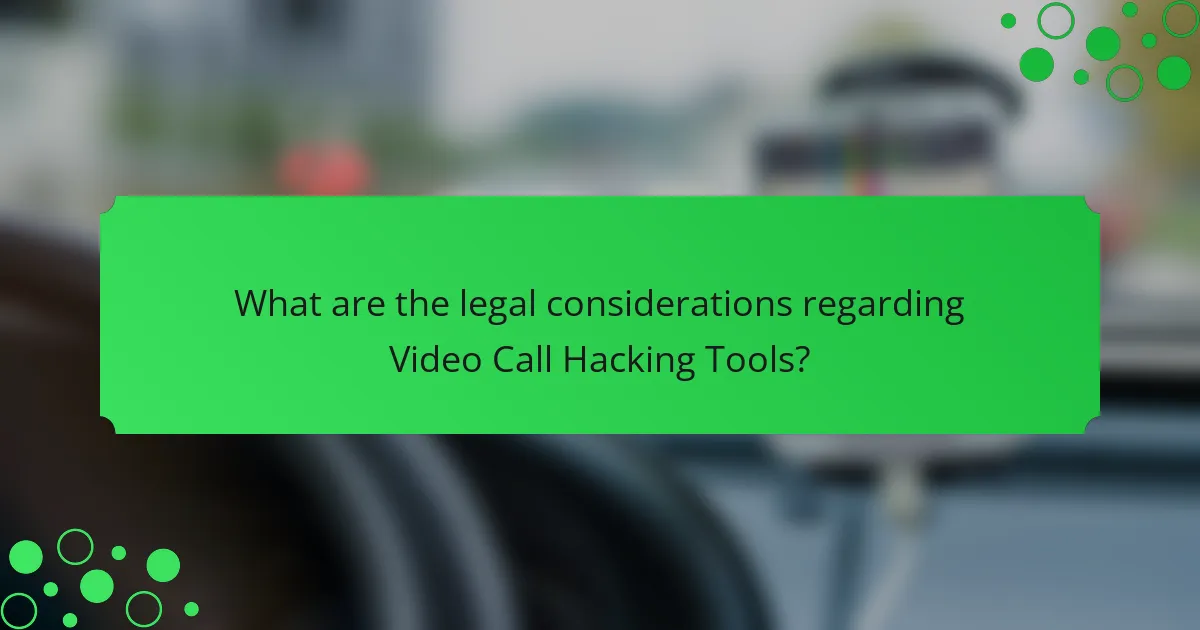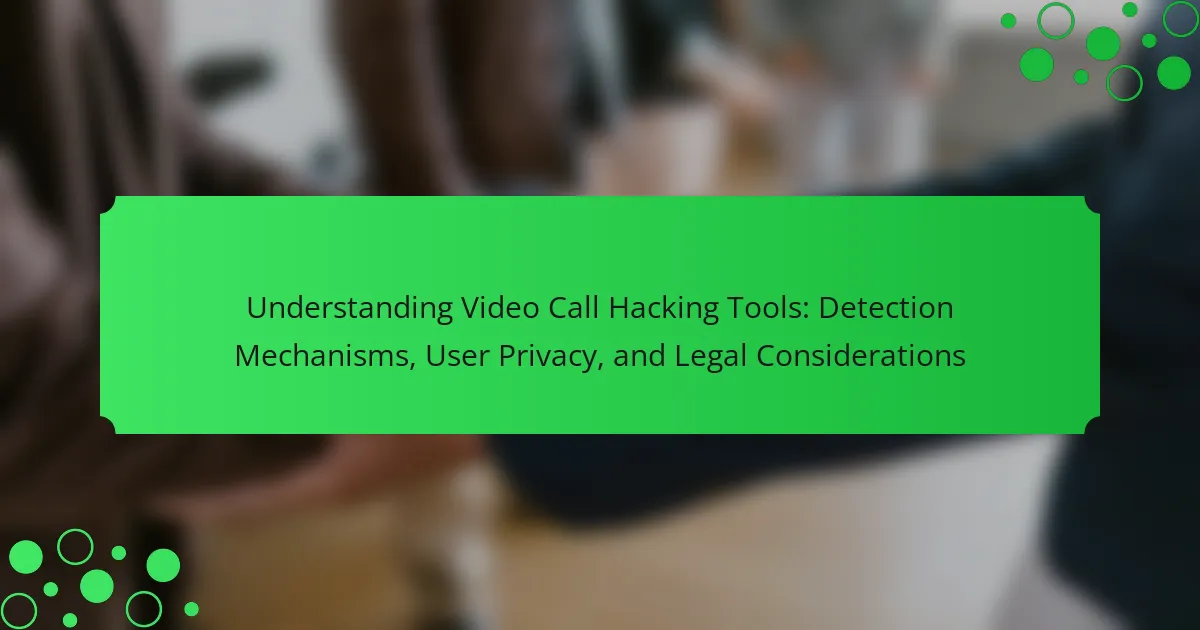Video call hacking tools are applications designed to exploit vulnerabilities in video conferencing platforms, allowing unauthorized access and compromising user privacy. Common functionalities of these tools include eavesdropping, recording without consent, and hijacking sessions, with prevalent targets being platforms like Zoom and Microsoft Teams. Detection methods for these hacking attempts involve monitoring unusual network activity, identifying anomalies in software behavior, and utilizing security software to scan for malware. Legal considerations surrounding video call hacking highlight that unauthorized access is illegal under various laws, with potential criminal charges and civil lawsuits for victims. Understanding the risks and implementing protective measures are essential for maintaining privacy during virtual meetings.

What are Video Call Hacking Tools?
Video call hacking tools are software or applications designed to exploit vulnerabilities in video conferencing platforms. These tools can enable unauthorized access to video calls, often compromising user privacy and security. Common functionalities include eavesdropping on conversations, recording calls without consent, or hijacking sessions. Reports indicate that popular platforms like Zoom and Microsoft Teams have been targeted by such tools. Cybersecurity experts emphasize the importance of using strong passwords and enabling two-factor authentication to mitigate risks. Awareness of these tools is crucial for maintaining privacy during virtual meetings.
How do Video Call Hacking Tools operate?
Video call hacking tools operate by exploiting vulnerabilities in video conferencing software. These tools can intercept data transmitted during calls. They may use malware to gain unauthorized access to devices. Some tools rely on phishing techniques to trick users into revealing credentials. Others exploit unsecured networks to capture video and audio streams. The effectiveness of these tools often depends on the security measures in place. For example, weak passwords can make systems more susceptible to breaches. Regular updates and security patches can help mitigate these risks.
What types of vulnerabilities do these tools exploit?
Video call hacking tools exploit several types of vulnerabilities. These include software vulnerabilities, such as outdated applications that lack security patches. They also target network vulnerabilities, like unsecured Wi-Fi connections that allow unauthorized access. Additionally, tools may exploit user behavior, such as weak passwords or phishing attempts that trick users into revealing sensitive information. According to a report by the Cybersecurity and Infrastructure Security Agency, 80% of breaches involve weak or stolen credentials. This highlights the importance of robust security practices to mitigate these vulnerabilities.
What are the common methods used in video call hacking?
Common methods used in video call hacking include phishing, malware, and unauthorized access. Phishing involves tricking users into revealing login credentials through fake emails or websites. Malware can be installed on a device to gain control over the video call application. Unauthorized access occurs when hackers exploit vulnerabilities in software to join calls without permission. According to a 2020 report by Cybersecurity & Infrastructure Security Agency, these methods have increased as remote work became more prevalent.
What are the potential risks associated with Video Call Hacking Tools?
Video call hacking tools pose several potential risks to users. These tools can lead to unauthorized access to personal and sensitive information. Hackers may gain control over users’ webcams and microphones, resulting in privacy invasions. Such breaches can facilitate identity theft and financial fraud. Additionally, these tools can be used to disrupt business meetings, causing operational disruptions. Malware associated with hacking tools can infect devices, leading to data loss. Users may also face legal repercussions if their compromised accounts are used for illicit activities. The overall impact includes significant emotional distress and loss of trust in digital communication platforms.
How can these tools compromise user privacy?
Video call hacking tools can compromise user privacy by intercepting audio and video feeds. These tools can exploit vulnerabilities in software to gain unauthorized access. This access allows hackers to record conversations without consent. Additionally, malware can be used to capture keystrokes and personal data. Phishing attacks can trick users into revealing sensitive information. Furthermore, insecure networks can expose video calls to eavesdropping. Research indicates that over 70% of video conferencing platforms have security flaws. These flaws can be exploited to breach user privacy effectively.
What are the implications for sensitive information during video calls?
Video calls can expose sensitive information to unauthorized access. During video calls, data can be intercepted by hackers through various means. This includes exploiting vulnerabilities in the video conferencing software. Additionally, unprotected Wi-Fi networks increase the risk of eavesdropping. Users may inadvertently share sensitive information through screen sharing or background visibility. Research indicates that 70% of remote workers have shared sensitive data unintentionally during calls. Therefore, it is crucial to implement security measures, such as end-to-end encryption and strong passwords, to protect sensitive information during video calls.

How can Video Call Hacking Tools be detected?
Video call hacking tools can be detected through several methods. Monitoring unusual network activity is crucial. This includes identifying unexpected data transfers or spikes in bandwidth usage. Anomalies in video call software behavior can also indicate hacking attempts. For example, unexpected disconnections or the presence of unknown participants can be red flags. Additionally, using security software that scans for malware can help identify malicious tools. Regular software updates can patch vulnerabilities that hackers exploit. Awareness of privacy settings is essential; users should frequently review who has access to their calls. These detection methods are supported by cybersecurity research indicating that proactive monitoring reduces the risk of hacking significantly.
What detection mechanisms are available for identifying hacking tools?
Detection mechanisms for identifying hacking tools include signature-based detection, behavior-based detection, and heuristic analysis. Signature-based detection identifies known hacking tools through specific patterns or signatures. This method relies on a database of known threats. Behavior-based detection monitors the actions of software for suspicious activity. It can identify new or unknown hacking tools by their behavior rather than their signatures. Heuristic analysis evaluates the characteristics of software to predict potential malicious behavior. This method can flag tools that exhibit unusual patterns, even if they are not in the signature database. These mechanisms are crucial for maintaining cybersecurity and protecting user privacy.
How do software solutions help in detecting video call hacking?
Software solutions assist in detecting video call hacking through various mechanisms. They utilize encryption protocols to secure data transmission. This encryption makes it difficult for unauthorized users to intercept calls. Additionally, software can monitor network traffic for unusual patterns. These patterns may indicate potential hacking attempts. Real-time alerts are generated when suspicious activity is detected. Some solutions employ machine learning algorithms to identify anomalies. This technology learns normal usage patterns and flags deviations. A study by Cybersecurity Ventures indicates that proactive detection can reduce data breaches by 70%. Thus, software solutions are essential in maintaining video call security.
What role does user awareness play in detecting hacking attempts?
User awareness is crucial in detecting hacking attempts. It enables individuals to recognize suspicious activities and potential threats. Awareness includes understanding common hacking techniques, such as phishing and social engineering. Educated users are more likely to identify unusual behavior in their accounts or devices. Statistics show that 95% of cybersecurity breaches involve human error. Training programs can significantly reduce these errors. Regular updates on emerging threats enhance user vigilance. Ultimately, informed users serve as the first line of defense against hacking attempts.
What signs indicate a video call may be compromised?
Unusual background noises during a video call may indicate compromise. This can include echoes or static sounds not originating from the participants. Frequent disconnections or lagging video can also signal potential hacking. If participants notice unauthorized access or unfamiliar individuals in the call, it raises significant concerns. Additionally, unexpected changes in video quality or resolution can indicate tampering. Unusual behavior from participants, such as delayed responses or speaking out of context, may suggest compromised accounts. Lastly, if the call software shows signs of malfunctioning, such as crashing or displaying error messages, it may point to a security breach.
What technical anomalies should users be aware of?
Users should be aware of several technical anomalies related to video call hacking tools. These anomalies include unexpected audio or video disruptions during calls. Users may also experience unusual background noises or echoes that are not present in normal calls. Sudden disconnections or inability to connect to calls can indicate potential hacking attempts. Additionally, unauthorized access to camera or microphone can occur, leading to privacy breaches. Users should monitor for unusual software behavior or unfamiliar applications running during calls. Keeping software updated can help mitigate these risks. Awareness of these anomalies is crucial for maintaining user privacy and security during video calls.
How can users recognize unusual behavior during calls?
Users can recognize unusual behavior during calls by observing signs such as unexpected audio or visual disruptions. For instance, if the call quality suddenly drops or if participants appear frozen, this may indicate interference. Users should also be alert for unusual background noises that don’t match the environment. Another sign is if participants are unresponsive or exhibit delayed reactions. If the call interface behaves unexpectedly, like showing unfamiliar features, it may suggest tampering. Monitoring for unexpected participants joining the call is crucial as well. These indicators can help users detect potential hacking or unauthorized access during video calls.

What are the legal considerations regarding Video Call Hacking Tools?
Video call hacking tools are illegal under various laws. Unauthorized access to computer systems is prohibited by the Computer Fraud and Abuse Act in the United States. Many countries have similar laws against hacking and invasion of privacy. Using such tools can lead to criminal charges, including fines and imprisonment. Victims of video call hacking can also pursue civil lawsuits for damages. Legal consequences vary by jurisdiction, but the trend is toward stricter penalties. Protecting user privacy is a key legal consideration in this context. Compliance with data protection regulations is essential for software developers.
What laws govern the use of video call hacking tools?
The use of video call hacking tools is primarily governed by laws related to computer fraud and abuse, privacy, and wiretapping. In the United States, the Computer Fraud and Abuse Act (CFAA) prohibits unauthorized access to computer systems. Violating this law can lead to severe penalties, including fines and imprisonment. Additionally, the Electronic Communications Privacy Act (ECPA) protects the privacy of electronic communications, making it illegal to intercept or disclose such communications without consent. Many states also have their own laws regarding wiretapping and eavesdropping, which vary in terms of consent requirements. These laws collectively aim to protect user privacy and prevent unauthorized access to communications.
How do different jurisdictions approach video call hacking?
Different jurisdictions approach video call hacking with varying laws and regulations. In the United States, laws like the Computer Fraud and Abuse Act address unauthorized access to computer systems, including video calls. European countries may enforce the General Data Protection Regulation (GDPR), which emphasizes user consent and data protection. In Australia, the Telecommunications Interception and Access Act regulates the interception of communications, including video calls. Additionally, some jurisdictions lack specific laws on video call hacking, leading to reliance on broader cybersecurity and privacy laws. These differences create a complex legal landscape for addressing video call hacking globally.
What are the penalties for using or distributing these tools?
The penalties for using or distributing video call hacking tools can include severe legal repercussions. In many jurisdictions, unauthorized access to computer systems is a criminal offense. This can result in fines that range from hundreds to thousands of dollars. Additionally, individuals may face imprisonment for a period of months to several years, depending on the severity of the offense.
For instance, the Computer Fraud and Abuse Act in the United States imposes penalties for unauthorized access to protected computers. Violations can lead to fines and imprisonment of up to 20 years for aggravated offenses. Furthermore, distributing such tools can result in civil lawsuits from affected parties, leading to additional financial liabilities.
The legal framework is designed to deter misuse and protect user privacy in digital communications.
What should users know about their rights and responsibilities?
Users have specific rights and responsibilities regarding video call privacy and security. They have the right to secure their personal information against unauthorized access. Users are responsible for using strong passwords and enabling two-factor authentication. They should be aware of the privacy policies of the platforms they use. Users have the right to report suspicious activities or breaches. They are responsible for keeping their software up to date to protect against vulnerabilities. Users must understand that sharing sensitive information can increase their risk. They have the right to seek legal recourse if their privacy is violated. Overall, users should actively manage their digital presence to safeguard their rights.
How can users protect themselves legally in case of hacking incidents?
Users can protect themselves legally in case of hacking incidents by documenting all evidence of the breach. This includes saving emails, screenshots, and logs related to the incident. They should report the hacking to local law enforcement and file a complaint with the Federal Trade Commission (FTC) or equivalent authority. Consulting with a legal professional who specializes in cybersecurity law is advisable. Users should also review and understand their rights under data protection laws, such as the General Data Protection Regulation (GDPR) if applicable. Maintaining security software and regularly updating passwords can help prevent future incidents. Keeping records of all communications with service providers is essential for legal proceedings.
What resources are available for legal guidance on this issue?
Legal guidance resources for video call hacking issues include legal aid organizations, law firms specializing in cyber law, and government websites. The American Bar Association offers resources on technology and privacy law. The Electronic Frontier Foundation provides information on digital privacy rights. State bar associations often have referral services for legal experts in this field. Additionally, online platforms like LegalZoom can offer guidance on legal questions related to cyber incidents. These resources help individuals understand their rights and legal options regarding video call hacking.
What best practices can users implement to safeguard against video call hacking?
To safeguard against video call hacking, users should implement several best practices. First, always use strong, unique passwords for video conferencing accounts. Passwords should be at least 12 characters long and include a mix of letters, numbers, and symbols. Second, enable two-factor authentication whenever possible. This adds an extra layer of security beyond just a password.
Third, keep software updated. Regular updates often include security patches that protect against vulnerabilities. Fourth, use secure networks. Avoid public Wi-Fi for sensitive calls, as these networks can be easily intercepted.
Fifth, be cautious with meeting links. Only share them with trusted participants and avoid posting them publicly. Lastly, familiarize yourself with privacy settings. Adjust settings to limit who can join or view your calls. Following these practices significantly reduces the risk of video call hacking.
Video call hacking tools are software designed to exploit vulnerabilities in video conferencing platforms, leading to unauthorized access and privacy breaches. This article examines how these tools operate, the vulnerabilities they exploit, and the common methods used in video call hacking. It also highlights the potential risks associated with these tools, including privacy invasions and identity theft, while discussing detection mechanisms and the legal implications surrounding their use. Best practices for users to safeguard their information and rights in the digital communication landscape are also outlined.
